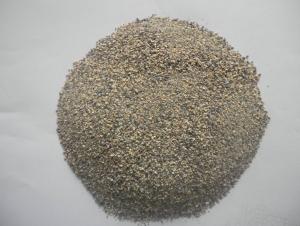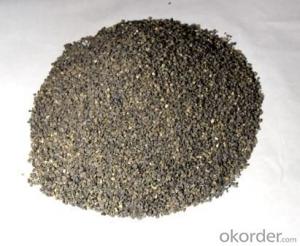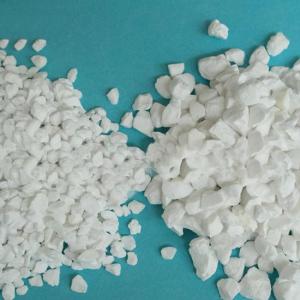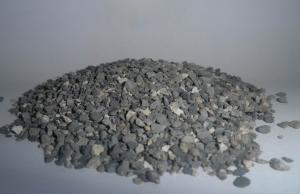Raw Materials for Refractory:Refractory Grade Calcined Bauxite for Alumina Cement
- Loading Port:
- Tianjin
- Payment Terms:
- TT OR LC
- Min Order Qty:
- 25 m.t.
- Supply Capability:
- 12000 m.t./month
OKorder Service Pledge
OKorder Financial Service
You Might Also Like
Refractory Grade Calcined Bauxite for Alumina Cement
Calcined Bauxite Introduction
Property | Specifications |
Name | aluminous soil ; bauxite |
Color | White, offwhite, auburnish yellow or light red (with Fe) |
Bulk Density | 2.55~3.6 g/cm3 |
Hardness | 1~3 |
Main usages | 1. Aluminium metallurgy 2.Refractory |
Calcined Bauxite Specifications

Calcined Bauxite Applications
1. Aluminium metallurgy
2. Precision casting / Investment casting:
bauxite grog fines can be made into mold for precision casting.
3. Refractory: high alumina bauxite’s refractoriness can reach 1780°C.
It is charactered by good chemical stability and mechanical performance. (Al2O3 ≥48% with low Fe2O3)
4. Aluminium silicate refractory fiber: The high alumina bauxite grog can melt under 2000°C-2200°C in the electric arc furnace.After a series of processing, it can become aluminium silicate refractory fiber,
which can be made into fiber blanket, plate,cloth.
5. Mixing magnesia and bauxite grog with binders to pour the molten steel ladle for better overall lining
performance.
Usage
1) The bauxite for aluminum industry in defense, aerospace, automotive, electrical, chemical, and daily supplies;
2) Bauxite clinker processed into fine powder and made after the casting mold. Used in military, aerospace, communications, instrumentation, machinery and medical equipment sector;
3) The bauxite can be used in refractory products. The refractoriness of high-alumina clinker is up to 1780 . Its features are chemical stability strong, and physical properties of sound;
4) It can manufact alumina cement, abrasive materials and aluminum compounds.
Pictures:
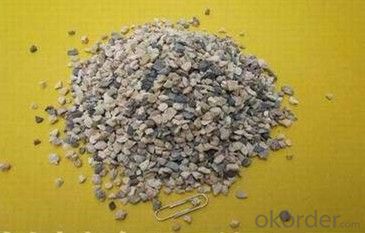


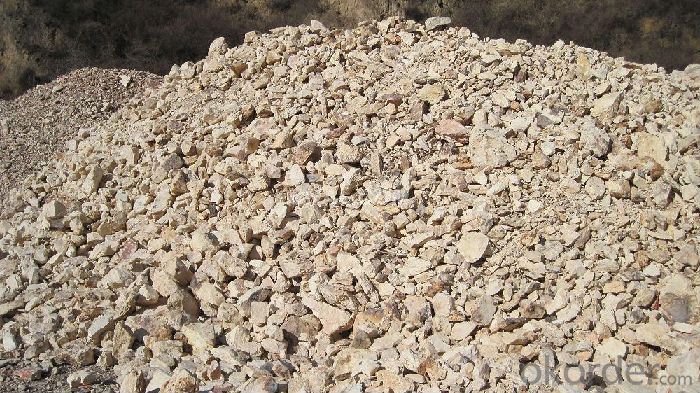
Remarks:
1) If you have special requirement for the specifications, we can have a talking to know if we can meet it. Usually, our skills and equipments are no problem. It's up to the production cost related to the bauxite raw ores we purchase;
2) Wide sizes variety is available as per customer's request.
- Q: what's the seal of fireproofing material?
- Organic fire-proof caulking is made by taking organic synthetic?resin as bond and compressing the components together after adding fireproofing agent, filler. The putty won't solidify after a long time usage and has good plasticity, can be sealed arbitrarily. This kind of putty is mainly applied in opening's fireproofing and sealing project of construction pipe and electric wire and cable, and it's used with ATD-AB and fire retardant bag together. ATD-AB is a kind of gray powder material, after mixed with water, it can be used for the opening sealing of electric wire and cable or fire resisting wall of wire tunnel. The fire proof blockage is non-toxic, and no smell, has good water resistance and oil resistance with simple construction methods. It's oxygen index is 100 and it belongs to incombustible?material. it's refractory time can reach 3 hours, or above or below. as for some projects for perpetual usage, WXY-II will save the project fee and make the project solid. A kind of fireproofing material that can automatically expand and foam and sealed by opening after injecting the foam into opening. Sealing strip is a product or flexibility coiled material mede by fireproofing material with certain geometry shape. Sealing gum is a kind of liquid fireproofing material that has a function of fireproofing and sealing. Fire retardant bag is soft and windable tape-shaped product made by fireproofing material, it is winded on the external surface of plastic pipe and fixed with steel belt or other proper methods, it's the expansion, squeezing and softening pipe after contacting with fire, opening left by burning or soften of seal plastic pipe. Fire retardant ring
- Q: Who knows about roof fireproofing materials?
- Roof water proofing materials: synthetic polymer waterproof rolls, high polymer modified asphalt waterproof coiled material, sheet metal, synthetic polymer waterproof coating, one-component water curing polyurethane waterproof coating, penetration crystalline waterproof coating. Secondly, we have to choose materials that are suitable for roof water proofing. The right waterproof materials have better waterproof performance, TS-3B one-component water curing polyurethane waterproof coating is very suitable and the performance is good. Since traditional roof waterproofing materials have requirements on the moisture content of the formation level which should be less than 9%. It is really important to choose which materials to repair leaking roofs. Kitchens and toilets are moisture, the formation levels of buildings are hard to satisfy requirements, thus, waterproof?layer and formation level are easily get separated and are ineffective in waterproofing.
- Q: I wanna ask that magnesium oxide is refractory?
- Magnesium oxide is used in refractory material, because it has the following characteristics and properties: 1, high stability: Anti-oxidation, anti-reduction, thermal decomposition; 2, high melting point, 2800 degrees; 3, low prices. In particular, the stability and melting point is very good, I hope I can give you help.
- Q: The classification of fire-resistant material
- Refractory material cna be divided into common and special fire proofing material. Common fire proofing material can be sub-divided in to acid fire proofing material, neutral fire proofing material. and alkaline fire proofing material according to chemical properties. Special fire proofing material can be divided into high temperature oxide refractory, refractory compounds and high temperature composite materials according to the composition. In addition, it also can be divided into common refractory products (1580 ~ 1770 ℃), high-grade refractory products (1770 ~ 1770 ℃) and super refractory products (above 2000 ℃) according to the strength . According to the shape, it can be divided into block (standard brick, special-shaped brick, etc.), special shape (crucible, sagger, pipe, etc.), fibrous (aluminum silicate, zirconia and boron carbide, etc.) and irregular shape (refractory clay, refractory castable, ramming material and so on). According to sintering process, it can be divided into sintered product, fused cast product and melting jetting product.
- Q: what's the fire endurance of fireproof?panel?
- Fire endurance of fireproof?panel is 3 hours, for example, 12 mm non-asbestos fiber reinforced calcium silicate board, fireproof?panel, two single 75 keel. through the monitoring of national fireproof construction materials quality supervision center, it's security and refractory time will reach over 3 hours. Fireproof board, also called fire endurance board, scientific name is thermosetting resin impregnated paper laminated wood.
- Q: The principle of choosing fire-resistant material in Thermal Energy and Power Engineering equipment.
- What thermal equipment? The most simple principle is durable, low cost and with no environmental pollution.
- Q: Do you know where I can buy refractories?
- Refractories are sold in following companies : Address of Huadu Refractories Co., Ltd. : NO.11 Huanjin Road, Fuyang, Hangzhou Address of Zhenxing Special Fire-Proof Material Co., Ltd. : No. 54 Pingjing Road, Yuhang District, Hangzhou Address of Zhongnai Refractories Co., Ltd.: No. 345 Fuyang, Hangzhou, Zhejiang Province
- Q: What needs to be paid attention to in the construction of high- temperature refractory mortar?
- In the construction of high-temperature refractory mortar, the following matters should be noted: 1. Take out the organic fire blocking material and knead it into tha shape of a ball. If the temperature is too low, the blocking material along with the package can be put into 40-70℃ warm water and heated before any other operation. 2. During the use of high-temperature daub masonry stove, the minimum mortar joint should be 0.5mm and general mortar joint should be 3-5mm, which can solve the processing and fine grinding of refractory brick on the brick grinder. Besides, it is conducive to the health of workers, and can reduce the masonry effort, ensure the quality and speed up the construction progress. 3. When making urgent repair on the stove, if the joint is much too large, 2-3mm refractory pieces can be appropriately added into the high- temperature refractory mortar, and stirred to fill the joint so as to shorten the repair time and ensure normal production. 4. High- temperature refractory mortar can be painted inside various furnace body, and it should be guaranteed that the surface of the furnace body has no dust or debris before painting. The holes should be cleaned up before plugging. Lay, embed, and fill the blocking material into the gap of holes evenly. For larger holes, flame screen can be used as the framework to increase strength.
- Q: What is glass furnace used high-grade refractory materials?
- Glass furnace need to use refractory that temperature resistance is more than 1600 degrees, corundum mullite brick, etc., What's more, in the key parts of the glass furnace needs to use chromium zirconium corundum material, such as alumina hollow brick and corundum brick.
- Q: What are the refractories for converter?
- Magnesia carbon material with large surface repair vessel, in addition to supporting the use of magnesia and magnesia cement.
Send your message to us
Raw Materials for Refractory:Refractory Grade Calcined Bauxite for Alumina Cement
- Loading Port:
- Tianjin
- Payment Terms:
- TT OR LC
- Min Order Qty:
- 25 m.t.
- Supply Capability:
- 12000 m.t./month
OKorder Service Pledge
OKorder Financial Service
Similar products
Hot products
Hot Searches
Related keywords













